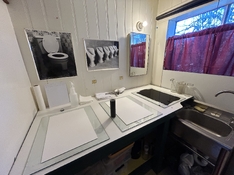This is a concept Calvin Grier launched recently: you make a regular DAS-sensitized carbon tissue, but you coat a thin layer of clear gelatin on top. This is supposed to help retain delicate highlights, and combat the 'tonal threshold' problem (as Calvin calls it).
Here's the video in which he explains it all:
He's also published an eBook that contains the same material as the video above: https://thewetprint.com/product/carbon-printing-with-inkjet-negatives/
The video is free, the eBook isn't.
I've done my first set of tests, but no luck so far. See my meager results here: https://tinker.koraks.nl/photograph...et-first-test-with-supercoated-carbon-tissue/
I'm honestly also not quite clear on how the concept it supposed to work at a theoretical level. The supercoat is unsensitized, so I don't really see how it's supposed to survive the warm water development step. In my tests, indeed it didn't and most of the image simply slid off the support during development. I'm wondering if others have already tried this (or are willing to dedicate some time to it).
I do not have the correct pair of gelatins for this to work, so perhaps that's why I'm running into trouble with it. IDK; I struggle to see how the unsensitized gelatin layer is supposed to work here.
Here's the video in which he explains it all:
He's also published an eBook that contains the same material as the video above: https://thewetprint.com/product/carbon-printing-with-inkjet-negatives/
The video is free, the eBook isn't.
I've done my first set of tests, but no luck so far. See my meager results here: https://tinker.koraks.nl/photograph...et-first-test-with-supercoated-carbon-tissue/
I'm honestly also not quite clear on how the concept it supposed to work at a theoretical level. The supercoat is unsensitized, so I don't really see how it's supposed to survive the warm water development step. In my tests, indeed it didn't and most of the image simply slid off the support during development. I'm wondering if others have already tried this (or are willing to dedicate some time to it).
I do not have the correct pair of gelatins for this to work, so perhaps that's why I'm running into trouble with it. IDK; I struggle to see how the unsensitized gelatin layer is supposed to work here.







